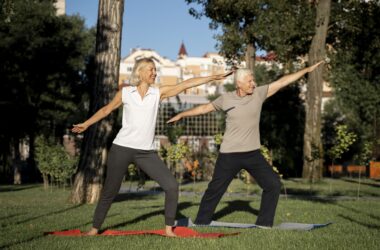The heartbeat is the music that keeps life going in a healthy body. In this blog, the changing effects of cardiovascular exercise on heart health and endurance are looked at. During this adventure, we’ll learn how different types of body movement can be used as a heart-healthy superhero workout. Take it as a kind of musical beat for your health!
We’ll talk about how cardiovascular exercises, or things that make your heart beat faster, work. Get ready to learn how experts approved cardiovascular exercise for heart health can help your heart stay strong and properly conditioned.
What is Cardiovascular Exercise?
Activities involving the heart and lungs, commonly referred to as “cardio,” are similar to physical exercise. Physical exertion like this strengthens and improves the function of your heart and lungs. Imagine your heart as a conductor of a beautiful symphony. Like a musical score, it directs the circulation of blood throughout your body.
Your heart rate will increase when you undertake these activities if you move steadily and regularly. Aerobic activities include things like jogging, cycling, swimming, and brisk walking. Not merely perspiring, but also coordinating the proper function of your cardiovascular system.
Cardiovascular exercise can help your heart become more efficient at pumping blood throughout your body. These workouts improve your heart’s ability to pump oxygen-rich blood to all of your cells by raising your blood pressure. A stronger heart is better able to do this, which is good for your cardiovascular health overall. Cardio exercises, whether you like swimming, bicycling through scenic areas, or dancing to music, all contribute to a healthier and stronger you.
Read More: Strength Training Methods
Importance Of Cardiovascular Exercise for Heart Health
Regular participation in moderate- to high-intensity exercise improves the cardiac muscle. As a result, your heart can pump blood more efficiently to your lungs and other parts of your body. Your blood’s oxygen content increases and more blood flows to your muscles as a consequence.
The small blood arteries in your body called capillaries also enlarge. This enables them to remove waste materials from your body and provide your body with more oxygen.
Which Cardiovascular Exercises Are Best For Heart Health?
Cardiovascular exercise benefits are diverse, and some of them are rather well-liked. Here are some of the best cardiovascular exercise:
Fast Walking
Walking quickly on your own is an excellent exercise. Nearly everyone can do it with ease. A park or even your own community could benefit from it.
Running
Running is a lot like doing regular exercise. In addition to building muscle and boosting cardiovascular fitness, it also facilitates fat loss. Get some exercise by running outside or on a treadmill.
Biking
Biking is an enjoyable way to do cardiovascular exercise. Either going for a ride outdoors or utilising a stationary bike are viable choices. In addition to helping your heart, it also builds muscle in your legs.
Swimming
The uniqueness of swimming as a form of exercise lies in the fact that it is easy on the joints. Just what it sounds like: a full-body, low-impact workout. You should be able to swim in a protected area, such as a pool.
Aerobic Workouts
This is a musical and movement workout. Maybe some dancing or step workouts are in store. Indulge in them and feel good about it for your heart. They are sometimes performed in teams.
Yoga
Yoga has a number of health benefits that heart patients may take advantage of and even profit from.
In actuality, exercise lowers blood sugar, which may be beneficial for those with cardiac issues. However, it seems that yoga in particular may benefit those recuperating from heart attacks.
These best cardiovascular exercises are great for people of all shapes and sizes. Walking, running, bicycling, swimming, or dancing are all acceptable forms of exercise. A healthy heart and general wellness are enhanced by all of them.

Read More: Functional Fitness
Where Should You Begin?
This step-by-step plan can help you make the switch and start doing exercise again:
Choose an Exercise That You Enjoy
The workout that you will really do, not the one you feel you should, is the greatest one for you. Walking is a fantastic place to start since you can do it anywhere and it doesn’t need any particular equipment.
If you’re not a walking person, anything that includes constant movement will do. Cycling, swimming, jogging, aerobics, rowing, climbing, dancing, and so on are all included in this.
Establish a Basic Schedule
You may not be aware of how much exercise your body can tolerate if you’re just getting started. Starting off with three days of exercise and one day off is a terrific idea if you’re a novice.
Don’t Forget to Warm Up and Cool Down
Start every aerobic activity with a five to ten minute warm-up. To raise your heart rate gradually, start with some gentle cardio. Pushing too hard or too quickly can simply exacerbate the pain.
Pick the Appropriate Velocity and Intensity
Strive for a little bit more effort than you are comfortable with, and continue for as long as you can.
Don’t Stress About Pace or Distance
For the first few weeks, concentrate on developing time and attending to your exercises. You have a lot of time to practise your distance and speed.
Modify Your Daily Schedule
Try adding an extra day of exercise, picking up the speed or intensity, trying a different activity, or increasing the amount of time you spend exercising every 4-6 weeks.
Read More: Guide to Meditation
7 Benefits of Cardiovascular Exercises
Cardiovascular exercise, sometimes known as cardio, has numerous advantages that go beyond simply breaking a sweat. Here are cardiovascular exercise benefits:
1. Strengthened Heart Muscle
Cardio exercises help to strengthen your heart. It’s similar to working out your heart, improving its efficiency in pumping blood throughout your body. This gradually strengthens your heart muscle, hence improving your cardiovascular health.
2. Improved Blood Circulation
Improved blood flow is another benefit of cardiovascular exercise. It’s similar to a highway system that becomes more efficient. Because of this improved blood flow, every part of your body gets the oxygen and minerals it needs.
3. Weight Management
Exercising helps burn fat. It’s as if your body is gradually depleting its stored energy. When paired with a nutritious diet, regular cardio exercise can be an effective technique for weight management.
4. Enhanced Mood and Reduced Stress
There is a relaxing effect to aerobic activity. When you exercise, your body releases endorphins and other feel-good chemicals. Of course, it also aids in lowering tension. After a heart-pumping workout, you could notice that your mood and level of relaxation have improved.
5. Lower Blood Pressure
Regular cardiovascular activity can help lower blood pressure. It’s like allowing your heart to stop beating for a while. As a result, the likelihood of hypertension and related health issues is reduced.
6. Increased Stamina and Endurance
Cardio should not be seen as a true sport, but rather as preparation for the marathon that is daily life. With time, your stamina and endurance improve. It’s like giving your body more resilience and ease in carrying out everyday duties.
7. Disease Prevention
Exercises that include the heart are crucial for preventing heart disease and other ailments. It’s like putting a shield around your heart. Regular exercise reduces the risk of diabetes, heart disease, and other related issues.
To get these advantages, you don’t need to exercise vigorously. Simple physical activities such as cycling, dancing, or brisk walking can have a significant impact. Put on your trainers or dancing shoes; the rhythmic investment in your overall health will be much appreciated by your heart.
Read More: Best Fitness Gadgets
How Often Should I do Cardiovascular Exercises
Try spending around 30 minutes a day, five times a week, doing aerobic workouts to stay in shape. Exercises that increase heart rate include brisk walking and cycling. Start with shorter sessions and increase them gradually as you become used to it if this is too much for you. It is essential that you exert consistent and regular effort. Choosing an enjoyable hobby or activity will help it to seem less like labour. It’s always a good idea to speak with a doctor to make sure it’s the correct decision for you if you’re unsure or feel exhausted. Keeping an active lifestyle will make you stronger and healthier.
Does a Healthy Diet Also Affect Heart Health?
Yes, what you consume determines who you are. Your body needs a range of nutrients from your food to provide the energy your tissues, organs, and heart need to be healthy.
For example, vitamin K, which is included in leafy greens such as kale and spinach, facilitates the heart’s ability to circulate blood freely throughout your body.
An essential mineral and electrolyte, potassium helps maintain healthy muscular function, particularly the muscles that regulate your heartbeat. It may be found in a variety of fruits, both fresh and dried, as well as several vegetables. .
Conclusion
During our journey, we learned that cardiovascular exercises and movement can help to strengthen our hearts. Walking and dancing are two examples of small activities that improve our hearts and keep us healthy. It’s important to do it often, consistently, and not too hard. So grab your trainers and start doing the things you enjoy most. It takes about thirty minutes a day to compose a resilience and joy song for oneself. It’s like having a good friend for your heart. Let’s keep this rhythm going and stay happy and strong together!
FAQs
Since swimming is low impact and suitable for all ages, it is regarded as the lowest impact cardio exercise. Try this interval if you want to raise your heart rate: Perform 10 sets of 10 laps, each lasting 30 to 45 seconds, with a 15-second break in between.
Exercises that are considered “pure” aerobics include walking, jogging, running, swimming, cycling, aerobics, rowing, stair climbing, hiking, cross-country skiing, and various forms of dance. Participating in sports like tennis, basketball, squash, and soccer may help increase your cardiovascular fitness.
Pick an aerobic exercise that you love doing, such as walking (either outdoors or on a treadmill), stationary swimming, cycling, rowing, or water aerobics.





